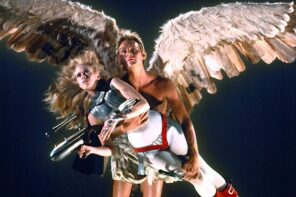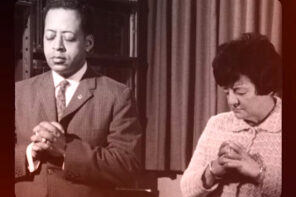Despite an American Idol judging gig, a baby girl with Orlando Bloom on the way, and her new album Smile due out August 28th, Katy Perry hasn’t been capturing the public’s attention like she did with 2010’s Teenage Dream. Back then, songs from “Firework” to “E.T.” dominated the airwaves, and she reached the still unsurpassed height of tying Michael Jackson’s Bad for most chart-topping singles off of one album.
And yet, separate from the ebb and flow of fame, this past decade has seen Perry forge farther ahead on a little-recognized personal journey, one typical of other artists who’ve drifted away from evangelical Christianity.
Although it might slip by someone who only glancingly knows her tunes, Katy Perry’s evangelical past is no big secret. In fact, it even formed a noticeably large chunk of her 2012 tour film-cum-bio doc Katy Perry: Part of Me. Then, theatergoers donned 3-D glasses and not only got lost in candy-colored concert clips, but also learned how a preacher’s kid went from idolizing Alanis Morisette to actually shocking her family with the relatively tame same-sex content of her breakout hit “I Kissed a Girl.”
What’s not so well known, however, is that Katy Perry’s evangelical past didn’t end there, but still filters into and shapes her life in ways that aren’t necessarily so obvious.
As Harvard historian David Hempton has observed in his book Evangelical Disenchantment, prominent artists who’ve shaped the larger culture include fairly few faithful evangelicals, but a decent number of people who’ve fallen away from those churches. Oddly enough, though, these latter figures tend to bear marks of the religious tradition that formed them, including a dislike of spiritual rigidity and a fervent sense of social mission.
Surprisingly, Hempton sees this dynamic at work, not just in distant personages like George Eliot and Vincent van Gogh, but also in someone like James Baldwin, whose thought and influence are still very much alive. Although best remembered for his novels and incisive cultural criticism, Baldwin spent several years as a teenage preacher in the historic Black wing of evangelicalism. Eventually deconverted by everything from Dostoevsky to the hypocrisy of other ministers, he would end up balancing distance from any church with affirmation of his essential belief in love, punctuating it all with condemnations of Christian complicity in the organized brutality of segregation and slavery.
Seen within this pattern of personal development, Katy Perry’s religious meanderings are slightly different from the typical faddish dillydallyings of many denizens of Southern California’s entertainment industry. From practicing Transcendental Meditation and meeting Pope Francis to depicting acupuncture and cupping in the video for her 2019 single “Never Really Over,” freedom is the point for Perry; raised in a strict religion, she now looks broadly for truth, without tying herself down to any one manifestation of it.
Similarly, her charitable and political activism again differ from typical Hollywood involvement. Yes, she’s served as a UNICEF Goodwill Ambassador, and yes, she campaigned for Hillary Clinton in 2016, performing at the Democratic National Convention and even donning a pantsuit tribute costume at a Philadelphia rally. But these are more than stereotypical celebrity attempts at changing the world. This form of doing good is very much tightly integrated into her identity like her older custom of trying to lead souls to Christ. After her 2017 album Witness made nowhere near her typical sales, Perry fell into a deep depression. Tellingly, that album was a self-professed attempt at “Purposeful Pop” that took on injustice and social isolation, so rejection of her music was compounded by rejection of her message, to devastating personal effect.
In this light, the self-realization strand to so much of Perry’s work takes on added significance; tropes like being a firework and letting your colors burst aren’t just an ideological legacy of the mid-20th century counterculture that went mainstream, but also a narrative that allows Perry to positively view her own deconversion. However much the song’s sentiments are now indistinguishable from a regnant Oprah-esque credo, “Firework” was inspired by a very particular passage from Kerouac’s On The Road about people who are “mad to live” and “burn like fabulous yellow roman candles.” In Katy Perry’s pyrotechnic trajectory, she didn’t lose religion; she found herself, and that true self includes a self-chosen gospel that she now feels strongly compelled to share with others.
To conceptualize religion’s effect on Katy Perry’s cultural presence it’s perhaps best to set aside James Baldwin and instead think of lapsed Catholic Madonna Louise Ciccone.
Katy Perry and Madonna both left their birth religion behind, both made it big in music, both dabble in the New Age and social change, and both cut tracks about being true to yourself. And yet, among these similarities, Katy Perry is the one singing achingly sincere songs on stripped-down acoustic guitar arrangements reminiscent of praise music, while Madonna is endlessly trying to scandalize with crucifixes and nuns’ habits as she produces videos and tours all with the ornate regimentation of a mass. For each of them, religion matters, but their different backgrounds have led them to parcel out their music and their celebrity presence in strikingly different ways; while Madonna can’t escape St. Peter’s, Perry still bears the signs and scars of the megachurch.
Since the Teenage Dream era, Katy Perry’s evangelical roots have been a known quantity. What the decade since has shown is that evangelicalism has shaped her more profoundly than the public and perhaps even she herself knows. In leaving behind the religion of her childhood, she found not the freedom of which she sings, but a script of a different sort.





